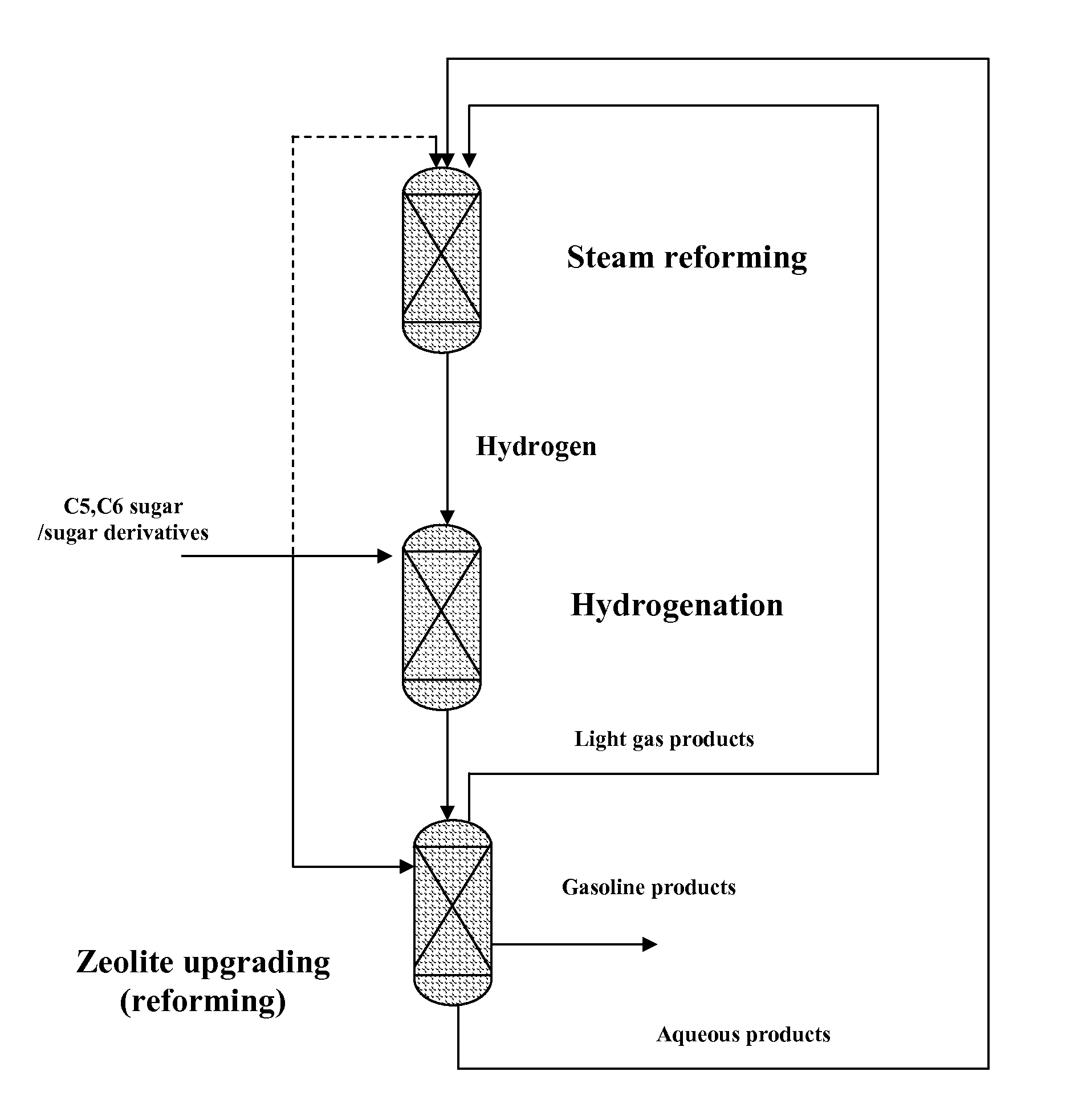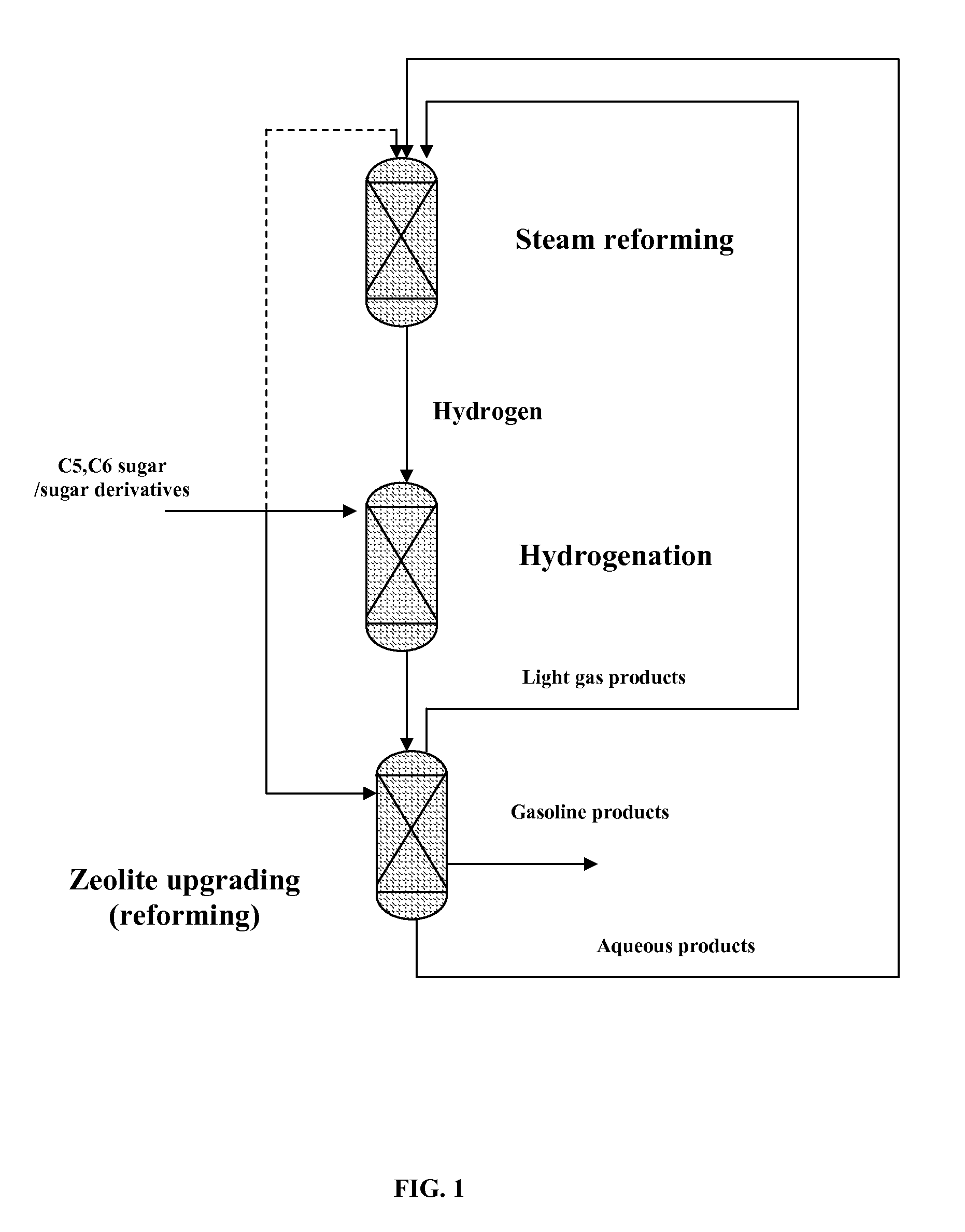Combination of zeolite upgrading with hydrogenation upgrading to produce renewable gasoline from biomass
a technology of hydrogenation upgrading and biomass, which is applied in the direction of hydrocarbon oil treatment products, metal/metal-oxide/metal-hydroxide catalysts, physical/chemical process catalysts, etc., can solve the problems of less aromatic products and relatively low density, and achieve low density, less aromatics, and reduced coke
- Summary
- Abstract
- Description
- Claims
- Application Information
AI Technical Summary
Benefits of technology
Problems solved by technology
Method used
Image
Examples
example 1
[0042]In one example, as shown in Table 1, hexane is a major product from sorbitol feedstock hydrogenation. Hexane was co-fed with sorbitol over a zeolite upgrading catalyst. The reaction was carried out at 450° C., 200 psig, with 8 g ZSM-5. The feed rates of sorbitol (70% sorbitol with 30% water) and hexane were 10 ml / hr and 12 ml / hr, respectively. Sorbitol conversion was 99%. The reaction products included greater than about 50% C5+ hydrocarbons with a high percentage of those hydrocarbons being aromatic (55.8%). The high aromatic content and large number of C5+ hydrocarbons led to a gasoline product with an approximate octane rating of 87-99. This is an ideal octane rating for high performance gasoline fuels and exceeds the required octane rating for “premium” gasoline in the United States and “superplus” gasoline in Europe. This experiment demonstrates that mixing a hydrogenated product, hexane, with the sorbitol feedstock produces a high octane gasoline quality fuel from a biol...
example 2
[0043]The process in example 1 was repeated with xylitol (50 wt % aqueous solution) instead of sorbitol. The same process conditions were used, the reaction was carried out at 450° C. (or 500° C.) 200 psig, with 8 g ZSM-5. Xylitol (50% xylitol with 50% water) and pentane were fed at rates of 10 ml / hr and 12 ml / hr, respectively. Xylitol conversion was 99%. The reaction products included about 50% C5+ hydrocarbons and an octane rating of 107. This high octane rating makes the fuel ideal for blending to increase the octane of fuels with lower octane ratings. Additionally, the high levels of conversion with xylitol indicate that polyols in general can be converted to gasoline quality fuels with high octane ratings of nearly 100 or greater than 100 from biological feedstocks comprising polyols and water. In addition, as shown in Table 2, the hydrocarbon product contains a low amount of CO2, low amount of coke and few undesirable by products. Xylitol (50% xylitol with 50% water) was fed a...
example 3
[0044]The process in example 1 was repeated with ethyl levulinate (100% ethyl levulinate) instead of sorbitol or xylitol. The same process conditions were used, the reaction was carried out at 450° C., 200 psig, with 8 g ZSM-5, and ethyl levulinate and pentane were fed at rates of 10 ml / hr and 12 ml / hr, respectively. Ethyl levulinate was completely converted. The reaction products included about 50% C5+ hydrocarbons and had an octane rating of 103.9. This high octane rating makes the fuel ideal for blending to increase the octane of fuels with lower octane ratings. Additionally, the high level of conversion with ethyl levulinate indicate that polyols in general can be converted to gasoline quality fuels with high octane ratings of nearly 100 or greater than 100 from biological feedstocks comprising polyols and water. In addition, as shown in Table I, the hydrocarbon product contains a low amount of CO2, a low amount of coke and few undesirable by products. Ethyl levulinate was fed a...
PUM
| Property | Measurement | Unit |
|---|---|---|
| pressures | aaaaa | aaaaa |
| pressures | aaaaa | aaaaa |
| temperature | aaaaa | aaaaa |
Abstract
Description
Claims
Application Information
 Login to View More
Login to View More - R&D
- Intellectual Property
- Life Sciences
- Materials
- Tech Scout
- Unparalleled Data Quality
- Higher Quality Content
- 60% Fewer Hallucinations
Browse by: Latest US Patents, China's latest patents, Technical Efficacy Thesaurus, Application Domain, Technology Topic, Popular Technical Reports.
© 2025 PatSnap. All rights reserved.Legal|Privacy policy|Modern Slavery Act Transparency Statement|Sitemap|About US| Contact US: help@patsnap.com


